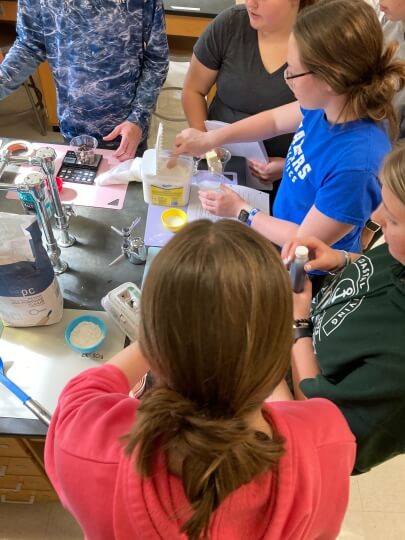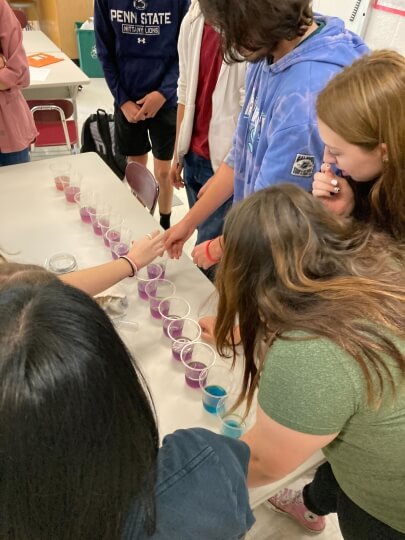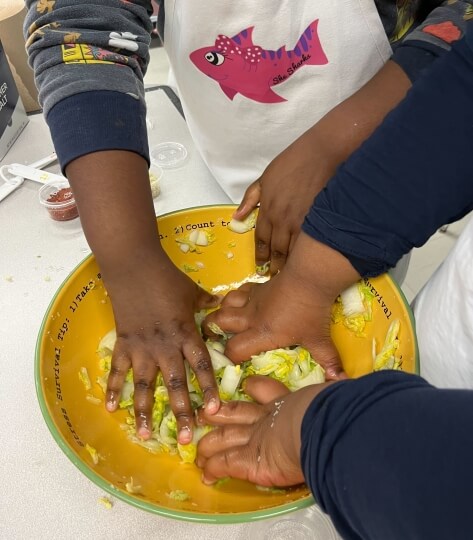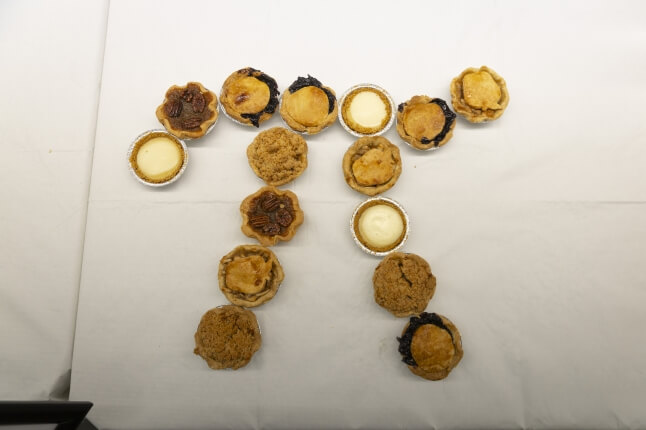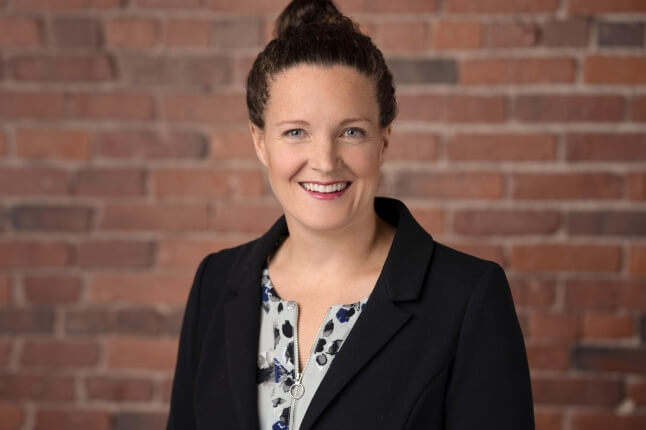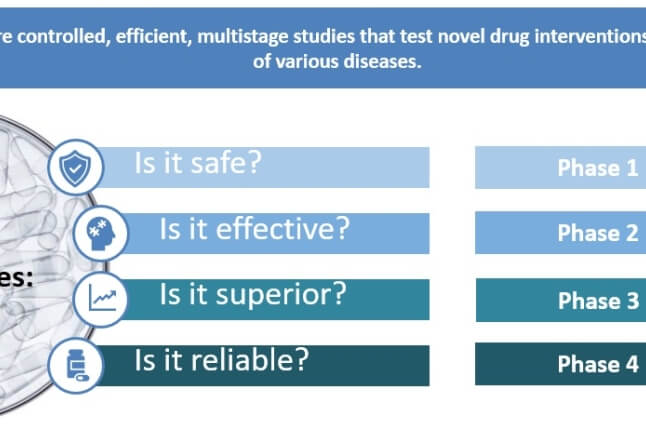News
Blue Ridge Middle/High School students learn about measurements and conversions as they make brownies. (Elizabeth Vaccaro)
High school chemistry teacher Elizabeth Vaccaro wanted to get her students more engaged in the classroom.
“I’d been searching for some way of engaging especially my general chemistry students, who’d really struggle with math,” said Vaccaro, who teaches at Blue Ridge Middle/High School, a school of just under 300 students in northern Pennsylvania. “They’d come in and were very patient and great kids, but they weren’t engaged in the way you need a student to be engaged to understand anything meaningful in chemistry.”
On a Facebook group for teachers, Vacarro came across summer workshops for middle and high school science teachers hosted by the Science and Cooking program at the Harvard John A. Paulson School of Engineering and Applied Sciences (SEAS) in collaboration with the Materials Research Science and Engineering Center (MRSEC). Through a collaboration with Kate Strangfeld, M.Ed. ‘22, and her initiative Bite Scized Education, SEAS has expanded its college-level program on science and cooking to create lessons specifically for use in classrooms for grades 6-12. Vacarro was one of 56 teachers to participate in these summer workshops. Vacarro began implementing the programming in her general chemistry class this year, and the response has been so positive that she’s begun to adapt the lessons for her honors class as well.
“I thought this might be a good way to connect with them, and they love it,” Vaccaro said. “So many of my students not only don’t know chemistry, but don’t know anything about cooking. The engagement is amazing, and I can’t say enough about how excited I am to be implementing these new ideas.”
Like Vaccaro, other teachers have found these lessons helpful to connect chemistry to their students’ everyday lives. Denise Puopolo, a chemistry teacher at East Boston High School, described how her students’ enthusiasm went beyond the scope of the classroom after they explored the science of browned butter. “A couple of the students took the brown butter recipe home. They wanted to make it with their younger sisters or brothers because they thought it was the coolest thing. It was fun to see the students get excited about the lesson.”
Blue Ridge Middle/High School study how liquid changes color. (Elizabeth Vaccaro)
Teachers like Vaccaro have to cover the required curriculum by the end of the school year. That can make it difficult to use alternative lesson plans, unless that programming has a clear basis in chemistry principles and fundamentals. The MRSEC and Bite Sized K-12 Science and Cooking program aligns with the Next Generation Science Standards, a set of guidelines developed by a group of 26 states in collaboration with the National Research Council, the National Science Teachers Association, and the American Association for the Advancement of Science, among other organizations. That sets the SEAS programming apart from other food-based programs, Vaccaro said, because it focuses on food as a way to understand chemistry and standard scientific principles.
“Our brownie lab is our dimensional analysis lab,” Vaccaro said. “We start with this bizarre recipe with crazy units, and they have to do unit conversions to change them into useful kitchen measurements. Then they have to figure out how to scale that to the pan or cupcake-size containers they actually have. There’s more math in those two days of pre-lab than I can coax from my general chemistry kids in two or three days of a traditional class, and they do it happily.
The Science and Cooking workshops also stand out because of their supplemental materials, which saves Vaccaro hours of time outside the classroom. Lessons come with readings clearly anchored in the chemistry underlying the cooking project, such as pepper and capsaicin as examples of polar and nonpolar molecules, and they also provide pre-built multimedia options such as slideshows and videos.
Oliver Hazard Perry School in South Boston make kimchi as part of a Science of Cooking lesson. (Michelle Woods Johnson)
“Science teachers are constantly searching for ways to connect grade-level appropriate reading to what’s happening in our science classrooms,” she said. “Often, we just say to open the textbook and read a section, but we all know those aren’t always the most engaging descriptions or discussions. This is all tailored for what’s happening in the classroom, and that’s money in the bank.”
In addition to readings, teachers can use step-by-step instructional lab videos to make complex content more accessible. Michelle Woods Johnson, a science teacher at Oliver Hazard Perry School in South Boston, used these videos when making fresh ricotta and kimchi in her “She Sharks” science club, which is intended to encourage 4-5th grade girls’ interest in science. After making kimchi, students explained the science behind what they observed. When describing her goals for the lesson, Woods Johnson said, “I wanted them to understand it's because of a certain environment that you set up that these organisms grow. Through that process, we humans get something out of it, which is the flavor in kimchi.”
Pennsylvania doesn’t require chemistry to graduate from high school, so Vaccaro’s 30 general and honors students take the subject as an elective. Alongside support from her school administration, Vaccaro also received two grants from her local community to cover the costs of supplies and safety equipment.
Along with lessons on brownies and peppers, Vaccaro has also implemented lessons on lemonade and acidity, the chemical and physical changes of butter, and popcorn as an example of matter changing states. Vaccaro says the SEAS Science and Cooking program makes chemistry a more digestible topic, increasing the excitement whenever students see SEAS workshops coming up on their lab schedule.
There’s no doubt that being able to eat your results is a non-trivial evolution of science programming, Everyone’s good to go, because they know the result will get them someplace fun, and they get to go out and brag that they made brownies, something their earth science friends aren't doing.
Sponsored by MRSEC (grant no. NSF DMR-2011754), Science and Cooking began as a General Education course called “Science and Cooking: From Haute Cuisine to the Science of Soft Matter,” in 2010. In conjunction with the course, which is taught by Pia Sӧrensen, Senior Preceptor in Chemical Engineering and Applied Materials, the program also offers a weekly public lecture series on campus that brings in chefs and restaurateurs from around the world. The Science and Cooking workshops for teachers are also sponsored by the MRSEC.
Cutting-edge science delivered direct to your inbox.
Join the Harvard SEAS mailing list.
Press Contact
Matt Goisman | mgoisman@g.harvard.edu
